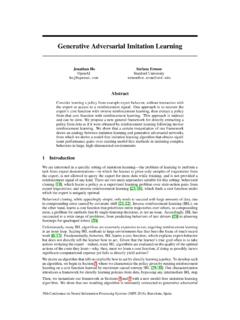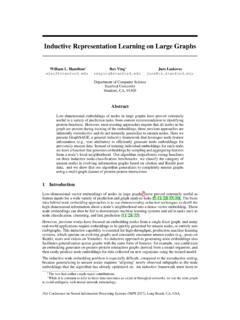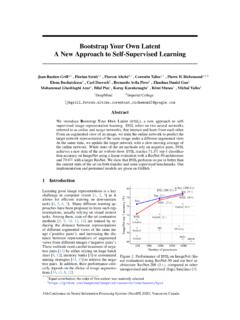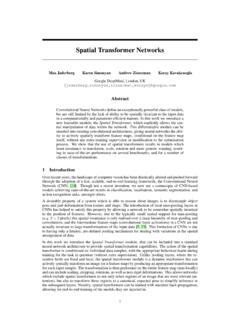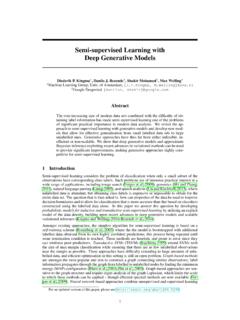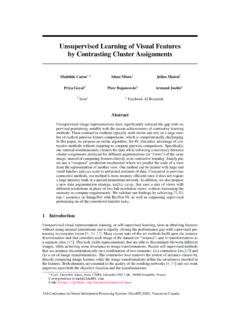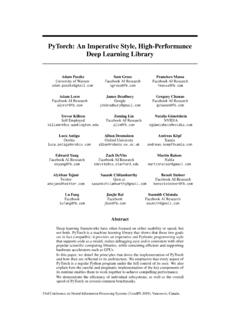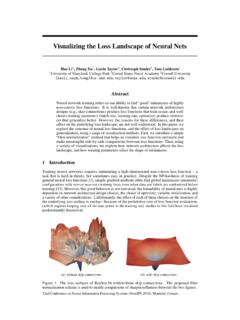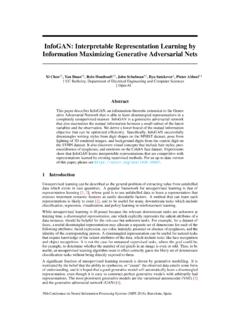Transcription of Prototypical Networks for Few-shot Learning - NeurIPS
1 Prototypical Networks for Few-shot LearningJake SnellUniversity of Toronto Vector InstituteKevin SwerskyTwitterRichard ZemelUniversity of TorontoVector InstituteCanadian Institute for Advanced ResearchAbstractWe proposePrototypical Networksfor the problem of Few-shot classification, wherea classifier must generalize to new classes not seen in the training set, given onlya small number of examples of each new class. Prototypical Networks learn ametric space in which classification can be performed by computing distancesto prototype representations of each class. Compared to recent approaches forfew-shot Learning , they reflect a simpler inductive bias that is beneficial in thislimited-data regime, and achieve excellent results. We provide an analysis showingthat some simple design decisions can yield substantial improvements over recentapproaches involving complicated architectural choices and meta- Learning . Wefurther extend Prototypical Networks to zero-shot Learning and achieve state-of-the-art results on the CU-Birds IntroductionFew-shot classification [22,18,15] is a task in which a classifier must be adapted to accommodatenew classes not seen in training, given only a few examples of each of these classes.
2 A naive approach,such as re-training the model on the new data, would severely overfit. While the problem is quitedifficult, it has been demonstrated that humans have the ability to perform even one-shot classification,where only a single example of each new class is given, with a high degree of accuracy [18].Two recent approaches have made significant progress in Few-shot Learning . Vinyals et al.[32]proposedMatching Networks , which uses an attention mechanism over a learned embedding of thelabeled set of examples (thesupport set) to predict classes for the unlabeled points (thequery set).Matching Networks can be interpreted as a weighted nearest-neighbor classifier applied within anembedding space. Notably, this model utilizes sampled mini-batches calledepisodesduring training,where each episode is designed to mimic the Few-shot task by subsampling classes as well as datapoints. The use of episodes makes the training problem more faithful to the test environment andthereby improves generalization.
3 Ravi and Larochelle[24]take the episodic training idea furtherand propose a meta- Learning approach to Few-shot Learning . Their approach involves training anLSTM [11] to produce the updates to a classifier, given an episode, such that it will generalize well toa test-set. Here, rather than training a single model over multiple episodes, the LSTM meta-learnerlearns to train a custom model for each attack the problem of Few-shot Learning by addressing the key issue of overfitting. Since data isseverely limited, we work under the assumption that a classifier should have a very simple inductivebias. Our approach, Prototypical Networks , is based on the idea that there exists an embedding inwhich points cluster around a single prototype representation for each class. In order to do this,we learn a non-linear mapping of the input into an embedding space using a neural network andtake a class s prototype to be the mean of its support set in the embedding space.
4 Classificationis then performed for an embedded query point by simply finding the nearest class prototype. We Initial work done while at Conference on Neural Information Processing Systems (NIPS 2017), Long Beach, CA, (a) Few-shotv1v2v3c1c2c3x(b) Zero-shotFigure 1: Prototypical Networks in the Few-shot and zero-shot : Few-shot prototypesckare computed as the mean of embedded support examples for each : Zero-shotprototypesckare produced by embedding class meta-datavk. In either case, embedded query pointsare classified via a softmax over distances to class prototypes:p (y=k|x) exp( d(f (x),ck)).follow the same approach to tackle zero-shot Learning ; here each class comes with meta-data givinga high-level description of the class rather than a small number of labeled examples. We thereforelearn an embedding of the meta-data into a shared space to serve as the prototype for each is performed, as in the Few-shot scenario, by finding the nearest class prototype for anembedded query this paper, we formulate Prototypical Networks for both the Few-shot and zero-shot draw connections to Matching Networks in the one-shot setting, and analyze the underlyingdistance function used in the model.
5 In particular, we relate Prototypical Networks to clustering [4]in order to justify the use of class means as prototypes when distances are computed with a Bregmandivergence, such as squared Euclidean distance. We find empirically that the choice of distanceis vital, as Euclidean distance greatly outperforms the more commonly used cosine similarity. Onseveral benchmark tasks, we achieve state-of-the-art performance. Prototypical Networks are simplerand more efficient than recent meta- Learning algorithms, making them an appealing approach tofew-shot and zero-shot Prototypical NotationIn Few-shot classification we are given a small support set ofNlabeled examplesS={(x1,y1),..,(xN,yN)}where eachxi RDis theD-dimensional feature vector of an exampleandyi {1,..,K}is the corresponding the set of examples labeled with ModelPrototypical Networks compute anM-dimensional representationck RM, orprototype, of eachclass through an embedding functionf :RD RMwith learnable parameters.
6 Each prototypeis the mean vector of the embedded support points belonging to its class:ck=1|Sk| (xi,yi) Skf (xi)(1)Given a distance functiond:RM RM [0,+ ), Prototypical Networks produce a distributionover classes for a query pointxbased on a softmax over distances to the prototypes in the embeddingspace:p (y=k|x) =exp( d(f (x),ck)) k exp( d(f (x),ck ))(2) Learning proceeds by minimizing the negative log-probabilityJ( ) = logp (y=k|x)of thetrue classkvia SGD. Training episodes are formed by randomly selecting a subset of classes fromthe training set, then choosing a subset of examples within each class to act as the support set and a2 Algorithm 1 Training episode loss computation for Prototypical the number ofexamples in the training set,Kis the number of classes in the training set,NC Kis the numberof classes per episode,NSis the number of support examples per class,NQis the number of queryexamples per (S,N)denotes a set ofNelements chosen uniformly atrandom from setS, without :Training setD={(x1,y1).]}
7 ,(xN,yN)}, where eachyi {1,..,K}.Dkdenotes thesubset ofDcontaining all elements(xi,yi)such thatyi= :The lossJfor a randomly generated training RANDOMSAMPLE({1,..,K},NC).Select class indices for episodeforkin{1,..,NC}doSk RANDOMSAMPLE(DVk,NS).Select support examplesQk RANDOMSAMPLE(DVk\Sk,NQ).Select query examplesck 1NC (xi,yi) Skf (xi).Compute prototype from support examplesend forJ lossforkin{1,..,NC}dofor(x,y)inQkdoJ J+1 NCNQ[d(f (x),ck)) + log k exp( d(f (x),ck ))].Update lossend forend forsubset of the remainder to serve as query points. Pseudocode to compute the lossJ( )for a trainingepisode is provided in Algorithm Prototypical Networks as Mixture Density EstimationFor a particular class of distance functions, known asregular Bregman divergences[4], the Prototypi-cal Networks algorithm is equivalent to performing mixture density estimation on the support setwith an exponential family density. A regular Bregman divergenced is defined as:d (z,z ) = (z) (z ) (z z )T (z ),(3)where is a differentiable, strictly convex function of the Legendre type.
8 Examples of Bregmandivergences include squared Euclidean distance z z 2and Mahalanobis computation can be viewed in terms of hard clustering on the support set, with one clusterper class and each support point assigned to its corresponding class cluster. It has been shown [4]for Bregman divergences that the cluster representative achieving minimal distance to its assignedpoints is the cluster mean. Thus the prototype computation in Equation(1)yields optimal clusterrepresentatives given the support set labels when a Bregman divergence is , any regular exponential family distributionp (z| )with parameters and cumulantfunction can be written in terms of a uniquely determined regular Bregman divergence [4]:p (z| ) = exp{zT ( ) g (z)}= exp{ d (z, ( )) g (z)}(4)Consider now a regular exponential family mixture model with parameters ={ k, k}Kk=1:p(z| ) =K k=1 kp (z| k) =K k=1 kexp( d (z, ( k)) g (z))(5)Given , inference of the cluster assignmentyfor an unlabeled pointzbecomes:p(y=k|z) = kexp( d (z, ( k))) k k exp( d (z, ( k)))(6)For an equally-weighted mixture model with one cluster per class, cluster assignment inference(6)is equivalent to query class prediction(2)withf (x) =zandck= ( k).
9 In this case,3 Prototypical Networks are effectively performing mixture density estimation with an exponentialfamily distribution determined byd . The choice of distance therefore specifies modeling assumptionsabout the class-conditional data distribution in the embedding Reinterpretation as a Linear ModelA simple analysis is useful in gaining insight into the nature of the learned classifier. When we useEuclidean distanced(z,z ) = z z 2, then the model in Equation(2)is equivalent to a linearmodel with a particular parameterization [21]. To see this, expand the term in the exponent: f (x) ck 2= f (x)>f (x) + 2c>kf (x) c>kck(7)The first term in Equation(7)is constant with respect to the classk, so it does not affect the softmaxprobabilities. We can write the remaining terms as a linear model as follows:2c>kf (x) c>kck=w>kf (x) +bk, wherewk= 2ckandbk= c>kck(8)We focus primarily on squared Euclidean distance (corresponding to spherical Gaussian densities) inthis work.
10 Our results indicate that Euclidean distance is an effective choice despite the equivalenceto a linear model. We hypothesize this is because all of the required non-linearity can be learnedwithin the embedding function. Indeed, this is the approach that modern neural network classificationsystems currently use, , [16, 31]. Comparison to Matching NetworksPrototypical Networks differ from Matching Networks in the Few-shot case with equivalence in theone-shot scenario. Matching Networks [32] produce a weighted nearest neighbor classifier given thesupport set, while Prototypical Networks produce a linear classifier when squared Euclidean distanceis used. In the case of one-shot Learning ,ck=xksince there is only one support point per class, andMatching Networks and Prototypical Networks become natural question is whether it makes sense to use multiple prototypes per class instead of just the number of prototypes per class is fixed and greater than1, then this would require a partitioningscheme to further cluster the support points within a class.
